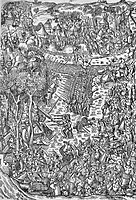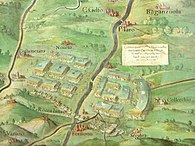
Italian War of 1494–1495
The First Italian War, or Charles VIII's Italian War,[2] was the opening phase of the Italian Wars. The war pitted Charles VIII of France, who had initial Milanese aid, against the Holy Roman Empire, Spain and an alliance of Italian powers led by Pope Alexander VI, known as the League of Venice.
"French invasion of Italy" redirects here. For the invasions of 1796–1797, see Italian campaigns of the French Revolutionary Wars. For the invasion at the end of World War II, see Second Battle of the Alps.25 January 1494: king died and was succeeded by his son Alfonso II of Naples (who also laid claim to Milan). King Charles VIII of France disputed the succession, and began preparations for an invasion of Italy to enforce his claim on the Neapolitan kingship.
Ferdinand I of Naples
5–8 September 1494: . A land battle involving the French fleet. French victory; Neapolitans abandoned Rapallo, which the French army sacked.
Battle of Rapallo
11 September 1494: French king Charles VIII and arrived in Asti and concluded an alliance with duke Ludovico Sforza and Beatrice d'Este.
Louis of Orléans
17 October 1494: skirmishes near . Tactical Neapolitan victories.
Sant'Agata sul Santerno
19–21 October 1494: . Franco–Milanese victory; the French soldiers sacked Mordano, the Milanese soldiers tried to protect the civilians.
Siege of Mordano
26–29 October 1494: Siege of Fivizzano. French victory; the French army sacked the town.
8–9 November 1494: Florentine revolt against de' Medici. Florentine republican victory; (who had submitted to all the French demands) was ousted, the Republic of Florence restored under the de facto leadership of Girolamo Savonarola.
Piero the Unfortunate
Mid-November – 28 November 1494: tense French occupation of Florence. An anti-French revolt or a French sack of the city was averted, and Charles VIII marched on to Rome.
31 December 1494 – 6 January 1495: peaceful French entry into Rome with 's permission, but some French looting took place.
Pope Alexander VI
? 1495: French conquest and destruction of the . French victory.
Castello di Monte San Giovanni Campano
22 February 1495: the French army captured Naples without a fight. fled the city to Sicily, but kept fighting the French army elsewhere. Charles VIII was crowned king of Naples, and he appointed Gilbert, Count of Montpensier as his viceroy. Likely, the first documented outbreak of syphilis in history occurred amongst the French troops at Naples.
Ferdinand II of Naples
31 March 1495: several Italian states (including Naples, Venice, Florence, Milan, the Papal States, Genoa and Mantua), Spain and the Holy Roman Empire formed the League of Venice to expel the French army from Italy. Milan defected from France to join the League of Venice.
2 May 1495: . League of Venice victory; the Genoese fleet defeated and captured the French fleet, and forced the French garrison of Rapallo to surrender. Much French war booty was lost, and Charles VIII's supply line was endangered.
Battle of Rapallo (1495)
30 May 1495: Charles split his army, leaving half of it behind to garrison the Kingdom of Naples, and taking the other half to march back to France.
28 June 1495: . French tactical victory; the French garrisons defeated the Neapolitan–Aragonese troops of Ferdinand II of Naples and Ferdinand II of Aragon (both Ferdinands were some of the last kings from the House of Trastámara).
Battle of Seminara
1 July 1495: Skirmish near Giarolo. Tactical League of Venice victory; Francesco II Gonzaga defeated a small French scouting force.
[4]
6 July 1495: . French tactical victory; the French army under Charles VIII managed to break through the forces of the League of Venice and march back to France, but lost nearly all the war booty.
Battle of Fornovo
6–7 July 1495: Neapolitan recapture of Naples. League of Venice victory; the Neapolitan–Aragonese troops defeated the French garrison of Naples, allowing Ferdinand II of Naples to return.
19 July – 21/24 September 1495:[5] Siege of Novara (1495). League of Venice victory; troops commanded by Beatrice d'Este managed to defeat and drive out Louis of Orléans.
[3]
6 July – 8 December 1495: Siege of the (Maschio Angioino) in Naples, where the French viceroy of Naples, Gilbert, Count of Montpensier, held out after the city of Naples was captured by the Neapolitan–Aragonese troops. League of Venice victory.
Castel Nuovo
9 October 1495: Charles VIII and Ludovico Sforza concluded the Peace of Vercelli between France and Milan. The Venetians and Spanish claimed they were not properly consulted, and objected strongly to Sforza's and 's alleged unilateral diplomatic actions.[6]
Francesco II Gonzaga, Marquess of Mantua
1496: England joined the League of Venice.
July–August 1496: . League of Venice victory; the French viceroy of Naples, Gilbert, Count of Montpensier, was forced to surrender to the Neapolitan–Aragonese troops, and died in prison in Pozzuoli in October 1496.
Siege of Atella
1497: .
Siege of Ostia
This is an overview of notable events including battles during the war.
Conflict[edit]
French invasion[edit]
Charles was preceded in Italy by his cousin Louis d'Orleans, who in July 1494 arrived in the territories of the Duchy of Milan with the vanguards of the French army, benevolently welcomed in Vigevano by the Dukes of Bari Ludovico Sforza and Beatrice d'Este, then settled in his fief of Asti. Only on 3 September 1494 King Charles moved to Italy through Montgenèvre, with an army of about 30,000 troops, of which 5,000 were Swiss mercenaries, equipped with modern artillery. Arriving in Piedmont he was greeted festively by the Dukes of Savoy, and then joined his cousin in the controlled County of Asti.
Charles VIII gathered a large army of 25,000 men, including 8,000 Swiss mercenaries and the first siege train to include artillery[1] He was aided by Louis d'Orleans victory over Neapolitan forces at the Battle of Rapallo which allowed Charles to march his army through the Republic of Genoa.
The Battle of Fornovo, Galleria delle carte geografiche, Vatican museums.
(1565). L'Historia di Milano. presso Giorgio de' Caualli.
{{cite book}}: Unknown parameter|agency=ignored (help)
Corio, Bernardino
Dina, Achille (1921). . Milan: Tipografia San Giuseppe. p. 366.
Isabella d'Aragona Duchessa di Milano e di Bari, 1471–1524
James, Carolyn (2020). . Oxford: Oxford University Press. p. 224. ISBN 9780199681211. Retrieved 1 June 2022.
A Renaissance Marriage: The Political and Personal Alliance of Isabella d'Este and Francesco Gonzaga, 1490–1519
Kokkonen, Andrej; Sundell, Anders (September 2017). (PDF). Gothenburg: University of Gothenburg. Retrieved 22 March 2022.
Online supplementary appendix for "The King is Dead: Political Succession and War in Europe, 1000–1799"
Mallett, Michael; Shaw, Christine (2012). The Italian Wars: 1494–1559. Pearson Education Limited.
Maulde-La-Clavière, René (1891). . Vol. 3. Paris: Ernest Leroux.
Histoire de Louis XII: première partie. Louis d'Orléans. Tome III
Nelson, Jonathan K.; Zeckhauser, Richard J. (2008). The Patron's Payoff: Conspicuous Commissions in Italian Renaissance Art. Princeton University Press.
Most sources, both the rewriting of Italian and French, state clearly that the French won at Fornovo, a triumph celebrated in a rare engraving of the battle made shortly after the event by an anonymous French artist. The conclusion of French victory is based on two factors: the Italians did not stop the northward march of the French, and the French sustained far fewer losses.
Pastor, Ludwig von (1902). The History of the Popes, from the close of the Middle Ages, third edition, Saint Louis: B. Herder 1902.
Volume V
Pellegrini, Marco (2009). Le guerre d'Italia : (1494-1530). Bologna. 978-88-15-13046-4.
{{cite book}}: Unknown parameter|agency=ignored (help)CS1 maint: location missing publisher (link)
ISBN
(1879). I diarii di Marino Sanuto (MCCCCXCVI-MDXXXIII) dall'autografo Marciano ital. cl. VII codd. CDXIX-CDLXXVII. Vol. 1. F. Visentini.
{{cite book}}: Unknown parameter|agency=ignored (help)
Sanudo, Marin
(1883). La spedizione di Carlo VIII in Italia. Venezia, Tip. del commercio di M. Visentini.
{{cite book}}: Unknown parameter|agency=ignored (help)
Sanudo, Marin
Summaripa, Giorgio (1496). . Venice: Christoforo Cremonese. Retrieved 22 April 2015.
Cronica de le cose geste nel Regno Napolitano
Luzio, Alessandro; Renier, Rodolfo (1890). "Francesco Gonzaga alla Battaglia di Fornovo (1495) Secondo I Documenti Mantovani". Archivio Storico Italiano Serie V (in Italian). 6 (179). Casa Editrice Leo S. Olschki s.r.l.: 205–246.
Santosuosso, Antonio (1994). "Anatomy of Defeat in Renaissance Italy: The Battle of Fornovo in 1495". The International History Review. 16, No. 2 (May) (2). Taylor & Francis, Ltd.: 221–250. :10.1080/07075332.1994.9640674.
doi
Kuiper, Kathleen, ed. (2009). The 100 Most Influential Painters & Sculptors of the Renaissance. Britannica Educational Publishing.
Nicolle, David (2005). Fornovo 1495: France's Bloody Fighting Retreat. Praeger illustrated military history series. Westport Connecticut: Osprey. 978-0-275-98850-0.
ISBN
(1978). The Papacy and the Levant (1204–1571), Volume II: The Fifteenth Century. Philadelphia: The American Philosophical Society. ISBN 0-87169-127-2.


